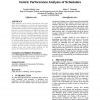169 search results - page 25 / 34 » Fine-Grained Timing Using Genetic Programming |
HPDC
2007
IEEE
14 years 4 months ago
2007
IEEE
Utility functions can be used to represent the value users attach to job completion as a function of turnaround time. Most previous scheduling research used simple synthetic repre...
ICRA
2002
IEEE
14 years 2 months ago
2002
IEEE
— In this paper, we present a method for co-evolving structures and controller of biped walking robots. Currently, biped walking humanoid robots are designed manually on trial-an...
BMCBI
2008
13 years 10 months ago
2008
Background: Testing for selection is becoming one of the most important steps in the analysis of multilocus population genetics data sets. Existing applications are difficult to u...
IEAAIE
2010
Springer
13 years 7 months ago
2010
Springer
An innovative technique based on multi-objective grammar guided genetic programming (MOG3P-MI) is proposed to detect the most relevant activities that a student needs to pass a cou...
CCIA
2005
Springer
14 years 3 months ago
2005
Springer
One of the main keys in case-based reasoning system is the retrieval phase, where the most similar cases are retrieved by means of a similarity function. According to the problem, ...



